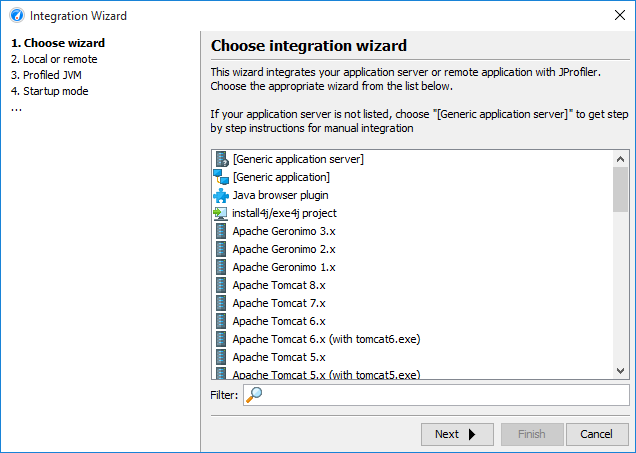We show 2 methods of installing JProfiler agent and accessing JVM to be profiled from remote location.
JProfiler is an award-winning all-in-one Java profiler and an alternative to jvisualvm. JProfiler’s GUI helps you detect performance bottlenecks, memory leaks and resolve threading issues. New features in 7.1 include i.a. JPA/Hibernate probe supporting Hibernate 3.x/4.x, EclipseLink 2.3+ and OpenJPA 2.1+. It is not cheap - comparing to jvisualvm ;) but some of you may have access to it’s license e.g. academic one or even qualify for open-source license.
As for remote access you will need a TCP port, login to Java Control Panel and on ‘Ports’ page determine a port number you are sure is not in use - for example one labelled OPENEJB_ADMIN or ask support for new port assignment for JProfiler exclusively.
Supported architectures: x86, x64/AMD64. Supported versions: 10/8/7, Server 2019/2016/2012. JProfiler and YourKit are both superior products with great profiling features serving all the needs which outruns the basic requirements. It is a matter of taste which of them to use and worth to evaluate both when looking for a profiling tool. JProfiler (standalone or plugin in IntelliJ) IntelliJ; A web application that you can profile; Understanding JProfiler. First JProfiler is a tool to understand what is going on inside a running JVM. Before we run the test, we should understand the basic functionality of JProfiler and how it will help us in performance improvement. Learn how to attach JProfiler to a remote JVM running in Kubernetes pod to profile the Java application. The approach uses an init container to make the JProfiler installation available to the JVM at startup time without baking JProfiler into the application's image.
Download JProfiler to your home directory and unpack it e.g.
Some of you may prefer to download RPM or shell installer. File locations may differ in that case.
Method 1: Start JProfiler with jpenable
Easier method for Java 1.6 or higher (which is rather typical version these days) but has the drawback that array allocations are not recorded, it means stack trace information for array allocations is not available. If you are profiling frequently you may prefer method 2 though.
Download the same tarball to your linux PC (or correct one for you OS), unpack and run jprofiler from bin directory.
- Click Session > New Session
- Choose ‘Attach to profiled JVM (local or remote)’
- Enter Host and Profiling Port as previously specified on the server and click OK
- Now Session > Open Session
- Choose the one just created
Jprofiler Free
Here are some screenshots of running JProfiler.
Download xcode for catalina.
Method 2: Add agentpath to JAVA_OPTS
Stop the JVM (you can use ‘jk’ shortcut command), add agentpath parameter to your JAVA_OPTS variable in ~/.bashrc and reread the file with ‘source ~/.bashrc’.
The library to be loaded is in our case {JProfiler install directory}/bin/linux-x64/libjprofilerti.so.
With jprofiler7 in your home directory and relative path, the example string to be added to JAVA_OPTS may look like

Jprofiler Eclipse
Or you can use an absolute path to libjprofilerti.so instead. Start JVM with Java Control Panel or js shortcut command. Check logs if you cannot connect.
Note: If you change any JVM/appserver settings in Java Control Panel the agentpath parameter will be removed so you may want to readd it. Alternatively you can ask support to add it to your static parameter set so that it survives JVM/appserver changes.
Jprofiler License

Jprofiler Vs Visualvm
The JProfiler Manual contains much interesting information on the profiling process, we recommend to read it in full to get most of JProfiler.




